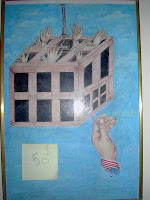From GrrlScientist at "Living the Scientific Life (or Scientist, Interrupted)", eight reasons why birdwatchers watch birds. Read the whole thing, but here's her final reason:
8. Finally, it can save your life. One day you will be walking home from work, depressed. Your kid has the flu; the car's clutch needs to be fixed; and you are thinking tomorrow is your birthday. Another year has passed, and once again you have not triumphed at anything, really. Then you glance at the sky in despair, and right there, right over your head, blessing that particular air space on your street forever, is the world's most beautiful bird! With pearly white head, black and white wings, long forked tail, it circles slowly, a hundred feet up, eating dragonflies, tearing off the wings and letting them flutter down -- while you toss your briefcase in a bush, grab the first person to come along, and shout, "A swallow-tailed kite! A swallow-tailed kite!" until he, too, looks up and blinks at the sight and knows suddenly that he must buy some binoculars and become a bird watcher himself.
Reason number five particularly resonated with me. Birds conjure up beauty and mystery and strangeness for me. They also are one of the most challenging photographic subjects, and that also appeals to me.
Another reason that birdwatching appeals to me is one that GrrlScientist doesn't mention: it's something that almost anybody can do from their home. We live in the foothills of the mountains just east of San Diego, California, and we have a little property out in the chapparal environment. With a few bird feeders and some reliable water, we get hundreds upon hundreds of bird visitors, prominently visible from every window in our home. The most common species are California quail, four different hummingbird species, California towhees, spotted towhees, California thrashers, house finches, lesser goldfinches, western bluebirds, and white-crowned sparrows. We have many other bird species as well: orioles, blackbirds, grosbeaks, sparrows, kingbirds, hawks, kites, osprey, tanagers, and many more. All observable, even if only on occasion, right from our home.


